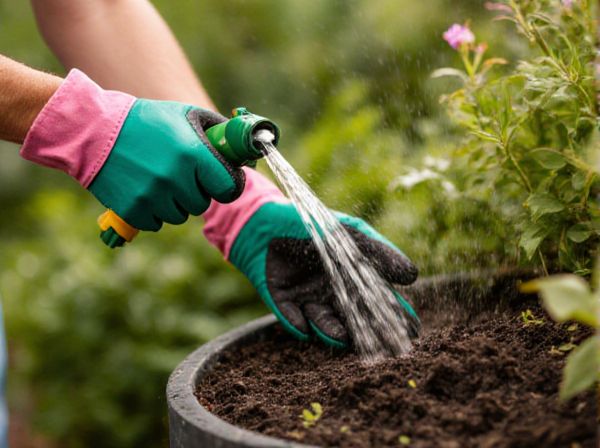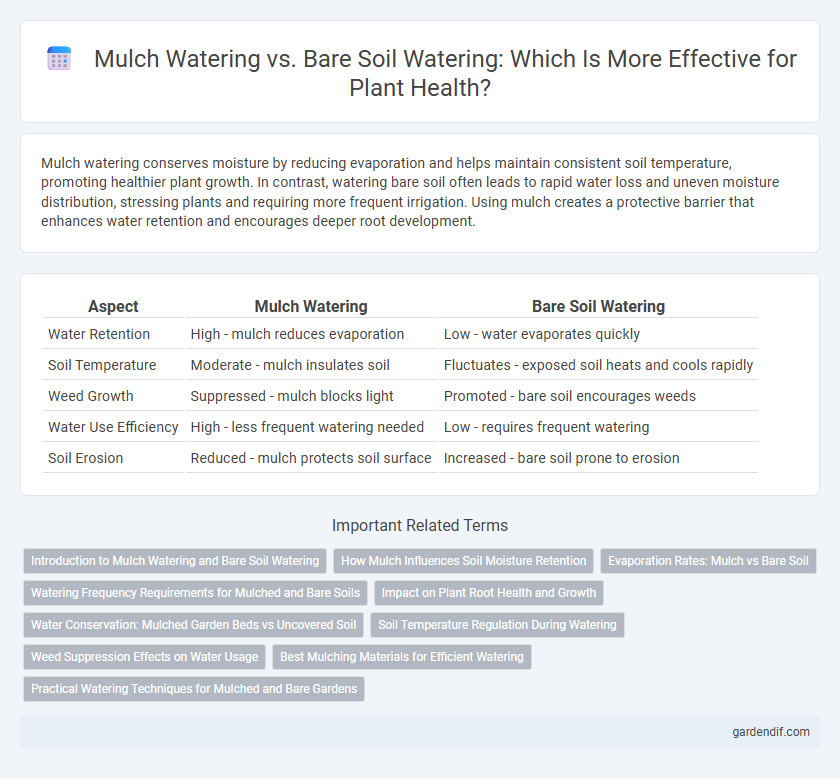
Mulch watering vs Bare soil watering Illustration
Mulch watering conserves moisture by reducing evaporation and helps maintain consistent soil temperature, promoting healthier plant growth. In contrast, watering bare soil often leads to rapid water loss and uneven moisture distribution, stressing plants and requiring more frequent irrigation. Using mulch creates a protective barrier that enhances water retention and encourages deeper root development.
Table of Comparison
| Aspect | Mulch Watering | Bare Soil Watering |
|---|---|---|
| Water Retention | High - mulch reduces evaporation | Low - water evaporates quickly |
| Soil Temperature | Moderate - mulch insulates soil | Fluctuates - exposed soil heats and cools rapidly |
| Weed Growth | Suppressed - mulch blocks light | Promoted - bare soil encourages weeds |
| Water Use Efficiency | High - less frequent watering needed | Low - requires frequent watering |
| Soil Erosion | Reduced - mulch protects soil surface | Increased - bare soil prone to erosion |
Introduction to Mulch Watering and Bare Soil Watering
Mulch watering involves applying water over a layer of organic or inorganic material spread on the soil surface, which helps retain moisture, reduce evaporation, and regulate soil temperature. Bare soil watering, conversely, directly wets the exposed soil, often resulting in faster evaporation and increased soil erosion risk. Using mulch improves water efficiency by maintaining consistent soil moisture and protecting plant roots compared to bare soil watering.
How Mulch Influences Soil Moisture Retention
Mulch significantly enhances soil moisture retention by reducing evaporation rates compared to bare soil, promoting more consistent hydration levels essential for plant health. Its organic layer acts as a protective barrier, minimizing water loss and aiding in maintaining optimal moisture for root absorption. Studies show mulched areas can retain up to 50% more moisture than exposed soil surfaces, leading to reduced watering frequency and better water conservation.
Evaporation Rates: Mulch vs Bare Soil
Mulch significantly reduces evaporation rates compared to bare soil by creating a protective barrier that retains moisture and maintains cooler soil temperatures. Studies show that mulched soil can lose up to 50% less water through evaporation, enhancing water conservation and improving plant health. Bare soil exposed to direct sunlight experiences rapid moisture loss, leading to increased watering frequency and reduced irrigation efficiency.
Watering Frequency Requirements for Mulched and Bare Soils
Mulch significantly reduces watering frequency by retaining soil moisture and minimizing evaporation compared to bare soil, which loses water rapidly and needs more frequent irrigation. Studies show mulched soils can maintain adequate moisture levels for up to 50% longer between watering cycles than bare soils. Gardeners using mulch typically water once or twice a week, while bare soil often requires watering three to four times weekly to sustain plant health and growth.
Impact on Plant Root Health and Growth
Mulch watering significantly improves plant root health and growth by maintaining consistent soil moisture, preventing evaporation, and reducing temperature fluctuations around the roots. In contrast, bare soil watering often leads to rapid water loss and temperature stress, which can cause root dehydration and hinder nutrient uptake. Mulched soil promotes deeper root development and enhances overall plant vitality by creating a stable and protective microenvironment.
Water Conservation: Mulched Garden Beds vs Uncovered Soil
Mulched garden beds reduce water evaporation by up to 30-50% compared to uncovered soil, promoting enhanced moisture retention and reducing irrigation frequency. Mulch acts as a protective barrier, minimizing surface runoff and allowing water to penetrate deeper into the root zone, improving plant hydration efficiency. This water conservation advantage makes mulching a sustainable practice for reducing overall water consumption in landscape management.
Soil Temperature Regulation During Watering
Mulch watering maintains stable soil temperature by insulating the soil, reducing fluctuations caused by direct sunlight and air exposure, which benefits root health and microbial activity. Bare soil watering exposes soil to rapid temperature changes, leading to increased evaporation and potential thermal stress on plants. Consistent soil temperature under mulch improves water retention and enhances overall plant growth efficiency.
Weed Suppression Effects on Water Usage
Mulch watering significantly reduces water evaporation and inhibits weed growth compared to bare soil watering, leading to more efficient water usage. The layer of organic or inorganic mulch acts as a barrier, preventing sunlight from reaching weed seeds and reducing their germination rates. Consequently, mulch watering preserves soil moisture and decreases irrigation needs, enhancing overall water conservation in gardens and agricultural fields.
Best Mulching Materials for Efficient Watering
Using mulch significantly improves watering efficiency by retaining soil moisture and reducing evaporation compared to bare soil. The best mulching materials for water conservation include organic options such as wood chips, straw, and shredded leaves, which not only maintain soil hydration but also enrich soil health through decomposition. Inorganic mulches like landscape fabric and gravel also effectively limit water loss, though they do not provide nutrient benefits.
Practical Watering Techniques for Mulched and Bare Gardens
Mulching improves water retention by reducing evaporation, allowing for deeper soil moisture and less frequent watering compared to bare soil. Bare soil requires more frequent, shallow watering due to higher evaporation rates and increased runoff. Practical watering techniques include drip irrigation for mulched areas to target roots efficiently, while bare gardens benefit from early morning watering to minimize water loss.
Mulch watering vs Bare soil watering Infographic

 gardendif.com
gardendif.com